Home > Which Heart Rate Monitor > Running Heart Rate Monitor
Running Heart Rate Monitor
Are you thinking of buying a good running heart rate monitor? We have done some research and on this page we show you what we have found.
Running heart rate monitors usually have features that distinguish them from other types of HRMs: for example, speed and distance measurements, lap counter and various countdown timers.
You will find below 2 groups of recommended running heart rate monitors: intermediate and advanced. The heart rate monitors are selected based on several factors, and the most important factor is favorable user reviews. So these monitors are among the top in terms of quality, reliability, and popularity.
If you are not too sure which running heart rate monitor to get, have a look at those listed below. Maybe one of them will suit you.
Recommended Intermediate Running Heart Rate Monitors
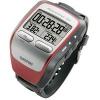 First, the Garmin Forerunner 305. It is the most popular model and packs a lot of features for its price. It is a GPS-enabled heart rate monitor primarily intended for outdoor running and uses satellite technology to measure speed and distance during a run. It also has GPS navigation features. Interestingly you can race against a Virtual Partner during a run. Naturally, it provides heart rate zone limits with alerts. What's more it can also provide time or distance or pace alerts. There is a choice of time-based or distance-based interval workout. It counts calories and takes laps. It has memory for multiple sessions and the training data can be transferred to both online and desktop software. It pretty much has everything that a runner may wish for. Better still, there are often great deals to be found on this model. That explains why Garmin Forerunner 305 is extremely popular with well over 2000 user reviews (more than any other HRMs) on Amazon!
First, the Garmin Forerunner 305. It is the most popular model and packs a lot of features for its price. It is a GPS-enabled heart rate monitor primarily intended for outdoor running and uses satellite technology to measure speed and distance during a run. It also has GPS navigation features. Interestingly you can race against a Virtual Partner during a run. Naturally, it provides heart rate zone limits with alerts. What's more it can also provide time or distance or pace alerts. There is a choice of time-based or distance-based interval workout. It counts calories and takes laps. It has memory for multiple sessions and the training data can be transferred to both online and desktop software. It pretty much has everything that a runner may wish for. Better still, there are often great deals to be found on this model. That explains why Garmin Forerunner 305 is extremely popular with well over 2000 user reviews (more than any other HRMs) on Amazon!
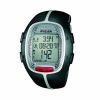 Next Polar RS300X SD comes with the S1 Foot Pod, offering user the ability to track speed and distance. Once calibrated, the S1 Foot Pod is very accurate. Since the S1 Foot Pod does not rely on GPS, it can be used both indoor or outdoor, and on different types of terrain. Heart rate training limits can be set up automatically or manually. It counts calorie burnt and also works out the percentage of that due to fat burning. It stores up to 99 laps and has 3 timers for interval training. During data review, you can view maximum and average heart rates, time in/above/below target zone, detailed lap information and more. In total it saves data for 16 workout sessions. It also comes with the Polar Fitness Test to help you monitor your long term fitness. Data can be uploaded to the Polar web site via the optional FlowLink device. Polar RS300X SD is the current replacement of the very successful Polar RS200 SD.
Next Polar RS300X SD comes with the S1 Foot Pod, offering user the ability to track speed and distance. Once calibrated, the S1 Foot Pod is very accurate. Since the S1 Foot Pod does not rely on GPS, it can be used both indoor or outdoor, and on different types of terrain. Heart rate training limits can be set up automatically or manually. It counts calorie burnt and also works out the percentage of that due to fat burning. It stores up to 99 laps and has 3 timers for interval training. During data review, you can view maximum and average heart rates, time in/above/below target zone, detailed lap information and more. In total it saves data for 16 workout sessions. It also comes with the Polar Fitness Test to help you monitor your long term fitness. Data can be uploaded to the Polar web site via the optional FlowLink device. Polar RS300X SD is the current replacement of the very successful Polar RS200 SD.
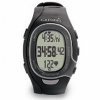 Now we come to Garmin FR60. It is available in different bundles containing different accessories. Unusually for a Garmin, the FR60 is not a GPS unit. When used with a foot pod, however, it provides speed and distance information, and allows you to set distance or pace alerts. It provides an interesting training feature called Virtual Partner to race against you while you are running. Other features include a heart rate training zone, a heart-rate based calorie counter, interval workouts, and a lap counter. It saves multiple run histories for later review. The USB ANT stick can be used to wireless transfer data to and from a computer automatically which is clearly a very convenient feature. The Garmin Connect online software then helps to analyse and plan your training.
Now we come to Garmin FR60. It is available in different bundles containing different accessories. Unusually for a Garmin, the FR60 is not a GPS unit. When used with a foot pod, however, it provides speed and distance information, and allows you to set distance or pace alerts. It provides an interesting training feature called Virtual Partner to race against you while you are running. Other features include a heart rate training zone, a heart-rate based calorie counter, interval workouts, and a lap counter. It saves multiple run histories for later review. The USB ANT stick can be used to wireless transfer data to and from a computer automatically which is clearly a very convenient feature. The Garmin Connect online software then helps to analyse and plan your training.
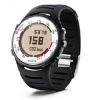 The Suunto T4d has a fairly unique feature called the Suunto Coach. What it does is that it analyses your current and past performance and produces a personal 5-day training plan. It makes recommendations for your workout in terms of exercise frequency, duration and intensity. Like most HRMs, you can set your heart rate training zone manually. The wrist watch shows you your real time average heart rate and your real time calorie burnt while you are training. It takes laps and offers a two segment interval timer. As an added plus it also uses digital wireless transmission to avoid interference. Finally it can be paired with an optional Foot Pod (or a GPS Pod) to give you speed and distance information.
The Suunto T4d has a fairly unique feature called the Suunto Coach. What it does is that it analyses your current and past performance and produces a personal 5-day training plan. It makes recommendations for your workout in terms of exercise frequency, duration and intensity. Like most HRMs, you can set your heart rate training zone manually. The wrist watch shows you your real time average heart rate and your real time calorie burnt while you are training. It takes laps and offers a two segment interval timer. As an added plus it also uses digital wireless transmission to avoid interference. Finally it can be paired with an optional Foot Pod (or a GPS Pod) to give you speed and distance information.
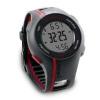 The Garmin Forerunner 110 is for someone who values simplicity and ease of use. It is a heart rate monitor that uses GPS to provide speed and distance information. It is extremely easy to use and provides only the essential information while you are out running. Simply lock on to the satellites, press start and off you go. The display is clear giving you distance, duration, heart rate and pace information. It has a heart-rate based calorie counter too. The Auto Lap feature marks a lap every time you have completed a certain distance. Training data can also be uploaded to Garmin Connect online software for further display and analysis. Garmin Forerunner 110 is a heart rate monitor for runners who want to know how fast and how far they are running, and yet don't want something too complicated. It has many good user reviews on Amazon.
The Garmin Forerunner 110 is for someone who values simplicity and ease of use. It is a heart rate monitor that uses GPS to provide speed and distance information. It is extremely easy to use and provides only the essential information while you are out running. Simply lock on to the satellites, press start and off you go. The display is clear giving you distance, duration, heart rate and pace information. It has a heart-rate based calorie counter too. The Auto Lap feature marks a lap every time you have completed a certain distance. Training data can also be uploaded to Garmin Connect online software for further display and analysis. Garmin Forerunner 110 is a heart rate monitor for runners who want to know how fast and how far they are running, and yet don't want something too complicated. It has many good user reviews on Amazon.
For those who want a running heart rate monitor without speed and distance measurements, then the following models are well worth considering: Timex Ironman Race Trainer, Polar RS100, Sigma Sport PC 15. Amongst the 3 models, the Timex Race Trainer has the most features and the Sigma Sport PC 15 the least. Different runners have different needs so be sure to check their specs. These heart rate monitors are all well regarded.
Recommended Advanced Running Heart Rate Monitors
First we meet the Polar RS800CX. Polar has been making heart rate monitors longer than practically everyone else, and its top model the RS800CX is one of the very best the market has to offer. The RS800CX has a few versions, one of them being RS800CX RUN and the other being RS800CX MULTI. We will look at both in turn.
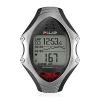 The Polar RS800CX RUN comes with the RS800CX wrist watch and the S3 Stride Sensor. This allows it to measure speed, distance, cadence, stride length and running index. It offers different types of heart rate training zones: manual, automatic and OwnZone. It has a calorie counter. It offers two special tests: Polar Fitness Test to see how fit you are, and Polar OwnOptimizer Test to see whether you have over- or under-trained. These tests can be very useful to serious runners to help them plan their training. It also measures heart rate variability and altitude. Further features include 99 laps and 3 timers for interval training. A large number of training data (too numerous to list them all here) can be reviewed post training. It stores data for up to 99 workout sessions and comes with the Polar ProTrainer 5 software to analyse those data. Lastly it uses digital transmission to avoid interference issues.
The Polar RS800CX RUN comes with the RS800CX wrist watch and the S3 Stride Sensor. This allows it to measure speed, distance, cadence, stride length and running index. It offers different types of heart rate training zones: manual, automatic and OwnZone. It has a calorie counter. It offers two special tests: Polar Fitness Test to see how fit you are, and Polar OwnOptimizer Test to see whether you have over- or under-trained. These tests can be very useful to serious runners to help them plan their training. It also measures heart rate variability and altitude. Further features include 99 laps and 3 timers for interval training. A large number of training data (too numerous to list them all here) can be reviewed post training. It stores data for up to 99 workout sessions and comes with the Polar ProTrainer 5 software to analyse those data. Lastly it uses digital transmission to avoid interference issues.
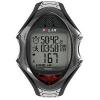 The Polar RS800CX MULTI comes with the RS800CX wrist watch and the G3 GPS Sensor. It uses GPS technology to measure speed and distance information (but no cadence, stride length etc). It support GPS tracking so you can see your route on the computer later. Just like the RS800CX RUN, it offers 3 types of heart rate training zones, a calorie counter, two tests, heart rate variability and altitude measurements, lap counter, interval timers, 99 session memory, Polar ProTrainer 5 software and digital transmission. This is an advanced heart rate monitor for outdoor multisport athletes who do running, cycling, hiking, or cross-country skiing etc.
The Polar RS800CX MULTI comes with the RS800CX wrist watch and the G3 GPS Sensor. It uses GPS technology to measure speed and distance information (but no cadence, stride length etc). It support GPS tracking so you can see your route on the computer later. Just like the RS800CX RUN, it offers 3 types of heart rate training zones, a calorie counter, two tests, heart rate variability and altitude measurements, lap counter, interval timers, 99 session memory, Polar ProTrainer 5 software and digital transmission. This is an advanced heart rate monitor for outdoor multisport athletes who do running, cycling, hiking, or cross-country skiing etc.
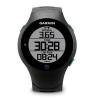 Now we come to Garmin. The Garmin Forerunner 610 is quite new and it uses built-in GPS technology to provide speed, distance, and navigation capabilities. The Touchscreen interface is used to change and select various features and options. That makes it really intuitive to use. It is possible to set alerts not only for heart rate limits, but also for time, distance and pace limits. Interestingly these alerts can be set to vibrate as well as to beep. It also offers features like Virtual Partner and Virtual Racer to run against you in order to help you improve (or sustain) your pace. There are interval training options, a lap counter and a calorie counter. The Forerunner 610 is one of the first Garmin heart rate monitors to measure your Training Effect, which indicates how your current activity is impacting your fitness. Now you know how your current session is doing to your physical fitness. The Forerunner 610 can save multiple run histories and wirelessly transfer them to a computer for analysis using the included desktop or online software. Lastly it can also be paired with an optional bike speed/cadence sensor. This GPS heart rate monitor is becoming really popular and has over a short period time collected a large number of good user reviews.
Now we come to Garmin. The Garmin Forerunner 610 is quite new and it uses built-in GPS technology to provide speed, distance, and navigation capabilities. The Touchscreen interface is used to change and select various features and options. That makes it really intuitive to use. It is possible to set alerts not only for heart rate limits, but also for time, distance and pace limits. Interestingly these alerts can be set to vibrate as well as to beep. It also offers features like Virtual Partner and Virtual Racer to run against you in order to help you improve (or sustain) your pace. There are interval training options, a lap counter and a calorie counter. The Forerunner 610 is one of the first Garmin heart rate monitors to measure your Training Effect, which indicates how your current activity is impacting your fitness. Now you know how your current session is doing to your physical fitness. The Forerunner 610 can save multiple run histories and wirelessly transfer them to a computer for analysis using the included desktop or online software. Lastly it can also be paired with an optional bike speed/cadence sensor. This GPS heart rate monitor is becoming really popular and has over a short period time collected a large number of good user reviews.
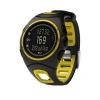 Finally we have Suunto. The Suunto T6d is an advanced heart rate monitor providing serious athletes with important metrics such as real time EPOC and Training Effect from heart rate variability and other measurements. It also incorporates an altimeter. It features a manual heart rate training zone, a calorie counter, an interval timer, and a lap counter and offers digital transmission. The training data can be uploaded online for further analysis. Suunto offers a number of external pods to increase the versatility of the T6d: Foot POD, GPS POD, Bike POD etc. The wrist watch comes in several colors to suit your preference.
Finally we have Suunto. The Suunto T6d is an advanced heart rate monitor providing serious athletes with important metrics such as real time EPOC and Training Effect from heart rate variability and other measurements. It also incorporates an altimeter. It features a manual heart rate training zone, a calorie counter, an interval timer, and a lap counter and offers digital transmission. The training data can be uploaded online for further analysis. Suunto offers a number of external pods to increase the versatility of the T6d: Foot POD, GPS POD, Bike POD etc. The wrist watch comes in several colors to suit your preference.
Copyright 2007-2011 Heart-rate-monitor-watches.com
|










